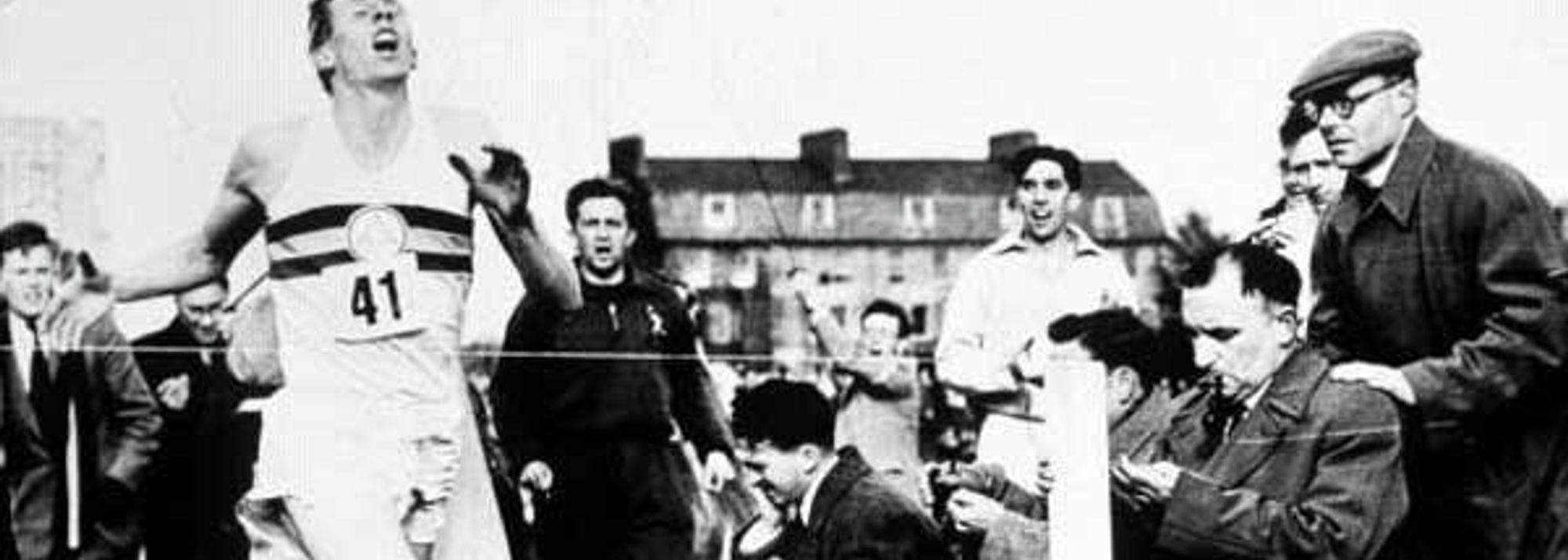Roger Bannister breaks the four minute mile barrier - 6 May 1954 - 3:59.4 (© Getty Images)
On your left as you enter the room which houses this collection of athletics memorabilia, the wall is adorned with numerous autographed photographs - Hannes Kolehmainen, Albert Hill, Douglas Lowe, Paavo Nurmi, Sydney Wooderson, Viljo Heino, Emil Zatopek….
The pictures of these middle and long distance running greats are hung next to the images of their more modern counterparts, Ron Clarke, Lasse Viren, Henry Rono, Steve Ovett, Sebastian Coe, Haile Gebrselassie, Maria Mutola, Gabriela Szabo….
In amongst this collection of sepia, black & white and colour images hangs, on first sight incongruously, a framed sheet of card on which in mono type is printed a list of event start times, distances, and the names of participants with their team or club allegiances.
Across the right hand side of this sheet by the Event ‘One Mile’ three signatures set at slightly jaunty angles have been penned.
On closer inspection this document, which has been unfolded to approximately A4 paper size, reveals the family names of Brasher, Bannister and Chataway.
50th Anniversary
Tomorrow, this folio from athletics history will celebrate its 50th birthday because of course this aesthetically insignificant item is dated 6 May 1954. It is the programme of the Oxford University versus the Amateur Athletic Association match, the meeting in which the first sub four-minute Mile was run.
Worldwide appeal
1609.36 metres, it doesn’t hold quite the same appeal as its imperial equivalent, of one Mile.
However, the Mile, the quintessential British racing distance has a worldwide appeal with athletes and fans of track and field alike. Why else was this the only imperial track race to avoid the chop when as from 1 January 1977 all non-metric distances were scrapped for World record purposes?
Outside the Anglo-Saxon world, the aura of the Mile has long captured the imagination of the world’s runners.
Finns and Swedes through the exploits of Nurmi, Gunder Hägg and Arne Andersson, and the records runs of the French masters Jules Ladoumegue and Michel Jazy, burn equally bright in the Mile’s history as any of the deeds of their American, New Zealand, Australian or British counterparts.
Latterly the African continent too has become mesmerized by the Mile’s Magic. Filbert Bayi, Noureddine Morceli, and Hicham El Guerrouj, are as essential to this athletics saga as are Sebastian Coe, Steve Ovett or Steve Cram.
Yet at it’s very heart, the Mile can never deny it’s birthright, and appropriately it is a Briton whose name is most famous of all the World Mile record breakers, Sir Roger Bannister.
On 6 May 1954 Bannister famously clocked 3:59.4 to become the world’s first ever sub-four minute miler.
The feat has often been described as the last hurrah of amateurism before the era of money and politics took sway over sport. Through singularly British eyes it was the beginning of a new Elizabethan age, perfectly in tune with the coronation of Queen Elizabeth II and the conquest of Everest that had taken place the previous year.
Individually, the famous trio took their own competitive rewards. Bannister won the European and Empire titles of that summer. Most memorably in the latter, Vancouver’s “Mile of the Century”, he beat Australia’s John Landy who in June 1954 had improved Bannister’s Mile mark to 3:58.0. Chataway also gained his fame in the autumn of 1954 setting a World 5000m record, and two years on Brasher was crowned Olympic Steeplechase champion.
Anything was then possible
Athletically the first sub-four marked the physical and psychological surmounting of the insurmountable and stood for so much more than just the wonderful athletics endeavours of Bannister and his two pacemakers.
In narrow sporting terms Herb Elliott, Peter Snell, John Walker, Hicham El Guerrouj and so many others reaped the harvest of that day. From that moment on anything was possible!
Symbolically 3:59.4 meant the dawning of a new age. Mankind was now more than ever able to conquer the elements. A new age of discovery in science, space travel and personal freedom was to follow.
Personal significance
Yet why should the events of 50 years ago still hold so much interest for this writer and collector who was not born for a decade after the event took place?
Well, as Bannister agonisingly fell through the finishing tape on that overcast evening on 6 May 1954, he fell into the arms of his good friend Nick Stacey, a 1952 Olympic sprinter, a Reverend, who a decade later would become my Godfather. With such a close connection to this historic moment I was perhaps athletics’ easiest ever convert!
Finally last Sunday, I was telephoned by David Powell, a friend and colleague, who is the respected Athletics writer for The Times newspaper. Knowing that I possessed a large track and field memorabilia collection he asked me how much value I would place on the vest and the spikes which Bannister wore that day and still owns.
Recalling that one of the stop watches used to time the record had been sold some years back for over £7000, I conservatively suggested a figure of around £50,000.
But perhaps on reflection, simply ‘priceless’ would have been a more honest answer!
Chris Turner
IAAF Editorial Manager
Note -
Sub-Four Minute Mile Celebrations
The IAAF Internet will be marking the 50th Anniversary of the first sub-four minute mile with a number of related articles and will also provide a report from tomorrow's celebrations which will take place in Oxford. The latter will include a Mile race which will start at 1800hrs, as did the original.



